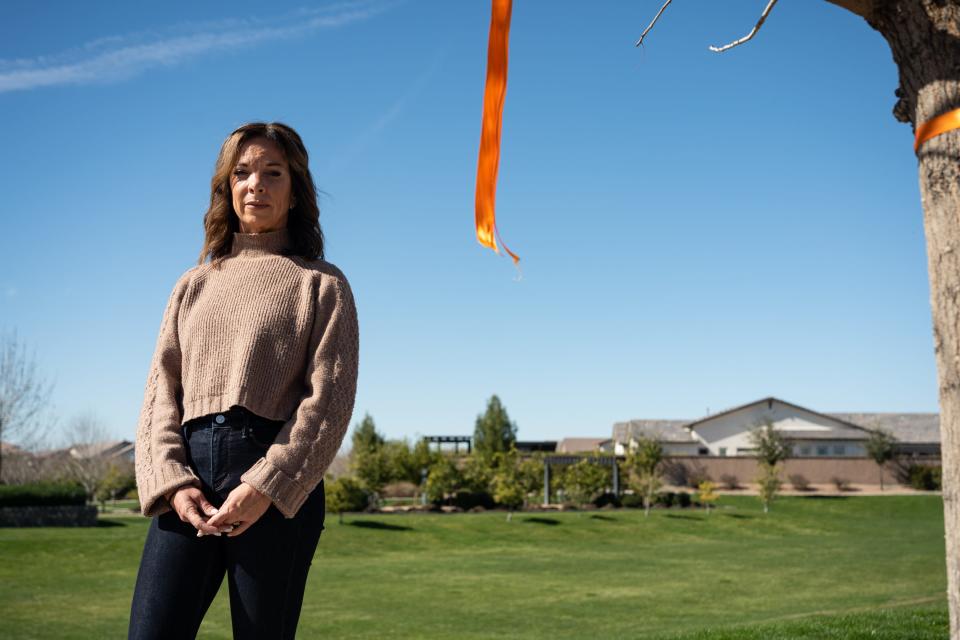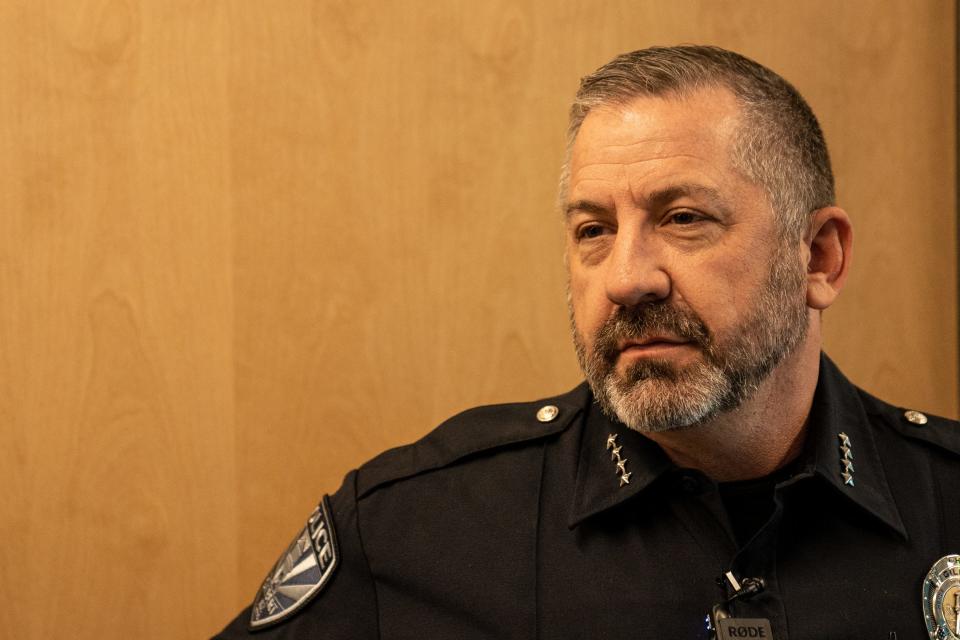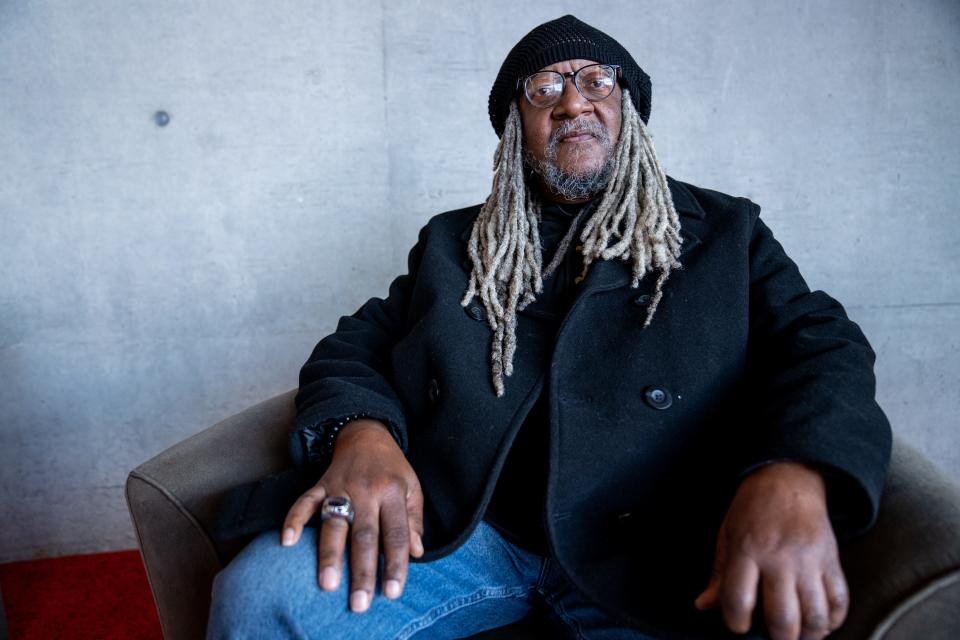'Gilbert Goons' gang is mostly white. Why were teens of color among early arrests?
When 16-year-old Preston Lord died after being beaten by a group of teens at a Halloween Party in Queen Creek, Kristine and Robert Brennan began paying close attention to videos of similar attacks circulating on social media.
It was obvious to the Brennans — and other concerned parents and southeast Valley residents who saw the videos — that most of the attackers appeared to be white teens. They were known as the "Gilbert Goons."
"Everything I had heard or seen around the Gilbert Goons, the majority of these kids that were committing the crimes in the videos I was watching, they were, honestly, they were white kids," said Kristine Brennan, 48, a Gilbert resident and business owner.
But when the first arrests tied to the Goons attacks were announced in January by the Gilbert Police Department, it was the mug shots of two young men of color — one Black, one Latino — that were splashed all over local and national media, quickly turning them into poster boys for a string of violent teen attacks in the suburbs east of Phoenix, primarily Gilbert.
The arrests of two people of color surprised and confused many, including the Brennans, who had seen video after video of packs of mostly white teens punching and kicking other teens in blitz-style attacks that occurred before and after Lord's death. No arrests have yet been made in Lord's homicide, although Queen Creek police have made multiple criminal referrals to the Maricopa County Attorney's Office.
"I just couldn't believe the first arrests were those two kids," Kristine Brennan said.
About 75% of Gilbert's 275,000 population is white. About 4% is Black, and about 17.6% is Latino, according to U.S. Census Bureau data. Gilbert's median household income is $105,733, considerably higher than Arizona's at $65,900, and among the highest in Maricopa County, according to the Maricopa Association of Governments.
Because they're 18, teens of color become poster boys of those arrested
The case that led to Gilbert police's first arrests since teen violence became a major focus in that southeast Valley involved the beating of Richard Kuehner’s then-16-year-old son in the parking lot of the Gilbert In-N-Out Burger.
It is one of several attacks involving members of the Goons that Gilbert police set aside or failed to connect to the string of group assaults. Kuenher was one of the first parents of a victim to publicly criticize Gilbert police for failing to address the assaults.
On the night of Aug. 18, Kuehner's teenage son came home bleeding profusely and was visibly shaken, Kuehner previously told The Republic. Goons attacked him, and it was filmed, he said.
When police were called that night, Kuehner's son told them the name of a 16-year-old involved in the attack, court records state. That white 16-year-old, the stepson of a principal of an elementary school in Gilbert, was interviewed and pointed himself out in a video of the attack, saying he was running to watch. The juvenile had his arms raised, stood in a "bladed stance," and appeared to be preparing to participate in the assault, according to court records.
After police first interviewed the 16-year-old, officials were "unable" to establish probable cause to arrest, Gilbert police said. The attack video was sent to school resource officers at southeast Valley high schools, but police said they could not identify suspects.
Gilbert police listed the case as "inactive" in early October. They didn't reopen it until after The Republic inquired about the attack in December.
When the 16-year-old was interviewed again after the case was reactivated in December, he blamed most of the fight on unidentified people of color. He said “two Black kids” approached Kuehner’s son that night, then a “Mexican kid” hit him in the face, police records state. Then, three “Black kids” and a “white kid” chased the victim.
On Jan. 10, Gilbert police confirmed Christopher Fantastic, 18, who is Black, had been arrested in connection with the beating. Hours later, the department confirmed that three more people were arrested: Aris Arredondo, 18, who is Latino, and two juveniles. The four were suspected of assault and robbery.
Another adult, 19-year-old Deleon Haynes, who is Black, and a 17-year-old juvenile were arrested later in January for the same Aug. 18 attack, also on suspicion of assault and robbery.
Only the mugshots of Fantastic and Arredondo — the two adults — were released by the Maricopa County Sheriff's Office on the day of the first arrests. The identities of the two juveniles arrested that day were not released by law enforcement and have been withheld by many news outlets, including The Arizona Republic, which does not typically publish the names of minors accused of crimes unless charged as adults.
After the Jan. 10 arrests, the story of suburban Arizona teens attacking other teens garnered wider interest. An article in the New York Post ran under the headline, "Affluent teen street gang ‘Gilbert’s Goons’ busted in string of caught-on-video attacks on high schoolers."
The Post story prominently featured photographs of Fantastic and Arredondo, which seemed to some readers to conflict with the headline, prompting racist comments.
"Affluent? Christopher Fantastic (really?) and Aris Arredondo don't look too affluent to me, they just look like the usual suspects," said one reader comment under the name Approve This.
"The pics confirm the stereotypes," said another reader comment under the name SlickWillies. "These 2 groups consistently" overrepresent.
The 16-year-old interviewed twice by police was among the three minors arrested in connection with the attack on Kuehner's son. But last week, Gilbert police said the Maricopa County Attorney's Office would not charge him. The police referral was "turned down," a police statement said.
Criminal cases are proceeding against Fantastic, Arredondo, Haynes and one minor, according to a statement Friday from the Maricopa County Attorney's Office, which did not specify the status of the case against the third minor arrested.
First arrests being people of color prompts lost trust, suspicion of police
Weeks later, parents, residents and civil rights leaders continue to raise questions about Gilbert police's handling of the Goons attacks, with some wondering whether police initially targeted two people of color to deflect public attention away from the white attackers and alleviate public pressure to take action.
At the time the arrests of Fantastic and Arredondo were announced, the Gilbert Police Department was facing withering criticism that it had been slow to respond and make arrests in the Gilbert Goons attacks.
"It kind of shows what kinds of white privilege is going on here," said Robert Brennan, 43. "Where you've got literal video evidence, you've got masses of people up in arms about this, and you go after the easier targets."
The quick arrests of Fantastic and Arredondo weakened his trust in the Gilbert police.
"It doesn't sit well," Robert Brennan said. "That wasn't who we were after. We were after these kids, but you didn't go after those kids. You went after some other kids."
Similar concerns were raised on social media.
"This is really not looking good. As the mother of black children, this is absolutely unnerving. Hold him accountable, yes. But what about the rest? This is just one disgusting injustice after another," Tamara Gooden wrote on Facebook under an azfamily.com article reporting the arrests of Fantastic and Arredondo. Kristine Brennan posted the article on a Facebook page named Lily Waterfield, which she uses to show support for the investigation into Lord's death, draw attention to the Gilbert Goons attacks and organize the community.
Teen violence: Why were 2 minors charged as adults in 'Gilbert Goons' attacks? What does it mean?
Katey McPherson, 50, does not believe the Gilbert police deliberately timed the arrests of Fantastic and Arredondo to deflect attention from white attackers. Nevertheless, that was the result.
"A lot of misinformation was put out due to the timing of the arrests," said McPherson, a youth mental health advocate who has become a major rallying force in the search for justice for Lord. "Because when you look across the span of the group, I would say 94% of them are Caucasian."
The false impression created by the timing of the arrests of Fantastic and Arredondo reflects an overall failure by the Gilbert police in handling the Gilbert Goons attacks, she said.
"They're not thinking or not mindful of the narrative, but they haven't been mindful of teenagers and teen violence in general anyways," McPherson said. "So, for me, it's just kind of a consistent pattern of incompetence."

Kiana Sears, president of the East Valley NAACP, said she was not so much surprised but suspicious when two people of color were the first to be arrested in the Gilbert Goons attacks, considering the attacks had been going on for a long time, and videos showed the attackers were mostly white.
"I was more like suspicious, wondering what is the spin that was happening," Sears said.
Sears said the arrests of Fantastic and Arredondo raise many questions. Were they among the first arrested because they stood out from the others? Did white attackers try to pin the blame on them?
Given the demographics of Gilbert, Sears also wondered if police were quick to arrest Fantastic and Arredondo to change public perception about the attacks, given that multiple people were involved in the attack.
"It was troubling that the first pictures posted were that of (people) of color," Sears said. "Was this a message being sent? Was there an intention? Was there an agenda?"
Were there people conspiring to create this perception that people of color were the attackers, Sears said, so "now the narrative changes ... where we no longer are saying that it's these white kids out here doing this?"
Lawsuit: 17 'Gilbert Goons' and parents sued over attacks; conspiracy alleged
Race played no role in arrests, Gilbert police chief says
Fantastic was arrested after Gilbert police on Dec. 22 posted images of the Aug. 18 attack on social media, asking for the public's help identifying the attackers.
Tips received from the public helped Gilbert police identify Fantastic as the Black male "with a distinct Afro hairstyle" shown attacking the victim in the screenshot of a social media video of the attack, according to police reports. In the screenshot, Fantastic's face "is clearly identifiable based on prior police interactions," the police report said.
According to the police report, Fantastic was among multiple people who attacked the victim in a parking lot. In the video, Fantastic punched the victim numerous times while he was on the ground trying to shield himself from the blows with his arms, according to the police report. Fantastic then stomped and kicked the victim multiple times while the victim was still on the ground.
"As this occurred, multiple other subjects in the video also punched and kicked the victim," the police report said. The victim's shoes were also stolen during the attack, prompting the robbery charges, the police report said.
The victim told police he believed the attack was in retaliation for reporting previous threats by subjects in the group to a police officer at his school, the police report said.
Arredondo, meanwhile, arrived at the Gilbert Police Department and agreed to cooperate two days after police posted screenshots of the incident and asked for the public's help identifying the attackers, according to a police report. Arredondo admitted he can be seen in the video stills, though he denied being involved in the attacks, the police report said. But "multiple tips" the police received identified Arredondo as "the Hispanic male" in the social media screenshots, according to the police report. The victim also identified Arredondo as the person who punched him in the mouth and initiated the altercation, the police report said.
The Arizona Republic was unable to reach Fantastic and Arredondo. Public defenders are representing both.
Gilbert Police Chief Michael Soelberg vehemently denied race played any role in the arrests of Fantastic and Arredondo.
"I want to categorically deny any insinuation that race plays a role in any arrest in Gilbert. Arrests are only made as new information becomes available and probable cause is established. Our primary focus is justice for all victims, the safety of our community and to put those responsible behind bars. To suggest otherwise is irresponsible and disheartening," Soelberg said in a written statement.

Soelberg said the Gilbert Police Department has long-standing relationships and partnerships with residents, organizations and businesses from all backgrounds.
"Under no circumstances is race ever a determining factor in the arrests of individuals by the Gilbert Police Department. Our officers take all reported crimes, investigations and arrests in our community very seriously," the statement said.
The Gilbert Police Department did not share the mugshots with media nor through the city's social media channels, Soelberg said.
The mugshots of Fantastic and Arredondo were released by the Maricopa County Sheriff’s Office, the agency responsible for booking and processing individuals brought into its custody, Soelberg said. The sheriff's office releases mugshots of adults who are booked.
Information involving juvenile arrest records is not releasable due to restrictions outlined in Arizona law unless and until the county attorney prosecutes the juvenile as an adult, Soelberg said. That's why Fantastic and Arredondo were identified on the day of the first arrests and the minors were not.
As more arrests are made, does the 'Goons' picture become clearer?
Floyd Galloway was president of the East Valley NAACP in the 1990s when a different gang, the Devil Dogs, formed in Gilbert and carried out similar attacks. The Devil Dogs later become involved in selling drugs with the Mafia.
Galloway sees parallels between the way the Gilbert police were criticized for being slow to respond to the Devil Dogs and the public uproar the department now faces in response to the Gilbert Goons and the quick arrests of Fantastic and Arredondo.
"With the Devil Dogs, it was white kids from affluent families that had the resources to try to protect their kids from the judicial system that these other kids (Fantastic and Arredondo) don't have," Galloway said. "Unfortunately, Gilbert to me has not changed much since the 1990s with the Devil Dogs because of this situation."
Galloway, a Tempe civil rights activist, also believes the Gilbert police handling of the Gilbert Goons attacks appears to reflect larger problems with policing in the U.S. in general, where white people with money are treated more favorably than people of color with fewer resources.
"Unfortunately, it's throughout this country where those who have money can get away with certain things until it hits a boiling point, but they'll use kids of color, people of color, as a scapegoat," Galloway said. "They try to paint a different narrative, and unfortunately, that's the same thing that has gone on in Gilbert."

Since the arrests of Fantastic and Arredondo, the Gilbert police have arrested about a dozen additional people tied to Gilbert Goons attacks.
Galloway said close attention needs to be paid to how the cases are prosecuted to see if bias becomes a factor.
Most of the additional people arrested are adults or juveniles charged as adults, so many of their names and mugshots have become public. That has presented a fuller picture of the attackers, said McPherson, the youth mental health advocate and community organizer.
"So if you have been following from start to finish, the story is pretty true," McPherson said. "The real truth is most of these children are Caucasian from middle- to upper-class families and have brutally attacked people for no apparent reason."
Galloway said he was unconvinced that public perception would shift from those first mug shots. He said he believed the images of Fantastic and Arredondo as the faces behind the Gilbert Goons attacks have been cemented in the public's mind.
"Yeah, the truth is coming out, but you still have that image, that stereotypical idea in the back of your mind of who was at the heart of it, which is untrue," Galloway said.
Reporters Elena Santa Cruz and Robert Anglen contributed.
Daniel Gonzalez covers race, equity and opportunity. Reach him at [email protected] or 602-444-8312.
This article originally appeared on Arizona Republic: Why were teens of color among the first arrests in 'Goons' attacks?
